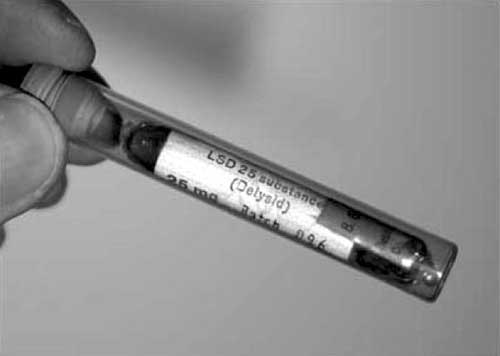Roman doctors described a disease called the sacred fire (sacer ignis) which by the Middle Ages came to be known as St. Anthony’s Fire: “an ulcerous Eruption, reddish, or mix’d of pale and red: and painful to the Patient,” as one 1714 text put it. This disease was ergotism: poisoning produced by exposure to the compounds found in a fungus that grows on wheat.
In the early decades of the twentieth century, pharmaceutical firms began investigating ergot, finding that it contained valuable medicinal compounds such as ergotamine, used to treat migraines. A Swiss chemist named Albert Hofmann became especially interested in this field, and in November 1938, in the week following Kristallnacht and the run-up to World War II, he first created a derivative of ergot that would later be dubbed lysergic acid diethalyamide: LSD.
It was not until five years later, however, that Hofmann returned to his invention. His discovery of the new drug’s profoundly psychoactive effects was one of the more famous accidents in the history of science.

A 1951 vial of LSD manufactured by Sandoz Laboratories, Albert Hofmann’s employer.
Immersed in the complex process of synthesizing the drug, Hofmann accidentally allowed a droplet of LSD to dissolve onto his exposed skin. He thought nothing of it: hardly any psychoactive drugs work in such small doses. Later that day, however, he found himself “affected by a remarkable restlessness, combined with a slight dizziness.” As he recollected in his book LSD: My Problem Child (1980) some forty years later, he went home sick, lay on his couch, and
sank into a not unpleasant intoxicated-like condition, characterized by an extremely stimulated imagination. In a dreamlike state, with eyes closed (I found the daylight to be unpleasantly glaring), I perceived an uninterrupted stream of fantastic pictures, extraordinary shapes with intense, kaleidoscopic play of colors. After some two hours this condition faded away.
Three days later, on April 19, 1943, the chemist decided to administer what he assumed was a tiny, threshold dose of the compound to himself in order to further test the effects of the drug. He took 250 micrograms, which is now known to be a high dose, roughly ten times higher than the threshold.
Within an hour Hofmann found his perception of the world to be strongly altered. He asked his lab assistant to escort him home—by bicycle. Cycling through the Swiss countryside, Hofmann was shocked to observe that “everything in my field of vision wavered and was distorted as if seen in a curved mirror.”
By the time he arrived home, Hofmann found the effects of the unknown drug alarming enough that he thought it wise to call a doctor. However, the physician reported no abnormal physical symptoms besides dilated pupils, and Hofmann began to enjoy himself, admiring
the unprecedented colors and plays of shapes that persisted behind my closed eyes. Kaleidoscopic, fantastic images surged in on me, alternating, variegated, opening and then closing themselves in circles and spirals, exploding in colored fountains, rearranging and hybridizing themselves in constant flux.
Hofmann awoke the next morning “refreshed, with a clear head,” and with “a sensation of well-being and renewed life… Breakfast tasted delicious and gave me extraordinary pleasure… the world was if newly created.” Hofmann was astonished: there was “no other known substance that evoked such profound psychic effects in such extremely low doses.” To this day, LSD is recognized as one of the most potent drugs known to medical science, and, as Hofmann realized early on, it is virtually unique in its ability to evoke “dramatic changes in human consciousness.”
One of the remarkable aspects of Hofmann’s story is how detached it was, both temporally and culturally, from the 1960s context with which LSD is often associated today. This delay between the scientific identification and the popular adoption of a drug is a common story.
Fans of Breaking Bad might be surprised to learn, for instance, that methamphetamine is actually a product of the nineteenth century. It was synthesized by the Japanese scientist Nagai Nagayoshi in 1893, but was not widely used until World War II, and failed to break into popular (and street) culture as a recreational drug of abuse until recent decades.
Similarly, LSD came into the world in the 1930s, but its remarkable effects were not even noticed until the 1940s, and it was not until the post-war era that it began to feature in medical studies and reach popular consciousness as a drug of abuse.
Hofmann’s invention left a profound legacy: much of our legal and cultural understanding of illicit drugs in the past five decades has been shaped by the impact of LSD. Like the early atomic scientists who were busy at work on the day that Hofmann rode his bicycle in 1943, it took time for the genie to come out of its bottle. But when it finally did, the world changed.
